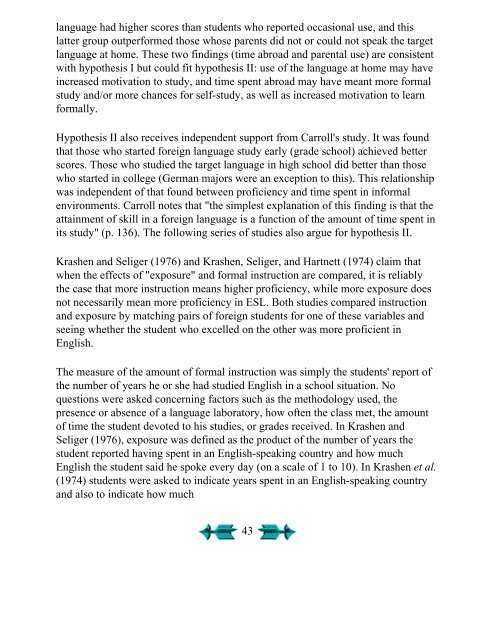Second Language Acquisition and Second ... - Stephen Krashen
Second Language Acquisition and Second ... - Stephen Krashen
Second Language Acquisition and Second ... - Stephen Krashen
You also want an ePaper? Increase the reach of your titles
YUMPU automatically turns print PDFs into web optimized ePapers that Google loves.
language had higher scores than students who reported occasional use, <strong>and</strong> this<br />
latter group outperformed those whose parents did not or could not speak the target<br />
language at home. These two findings (time abroad <strong>and</strong> parental use) are consistent<br />
with hypothesis I but could fit hypothesis II: use of the language at home may have<br />
increased motivation to study, <strong>and</strong> time spent abroad may have meant more formal<br />
study <strong>and</strong>/or more chances for self-study, as well as increased motivation to learn<br />
formally.<br />
Hypothesis II also receives independent support from Carroll's study. It was found<br />
that those who started foreign language study early (grade school) achieved better<br />
scores. Those who studied the target language in high school did better than those<br />
who started in college (German majors were an exception to this). This relationship<br />
was independent of that found between proficiency <strong>and</strong> time spent in informal<br />
environments. Carroll notes that "the simplest explanation of this finding is that the<br />
attainment of skill in a foreign language is a function of the amount of time spent in<br />
its study" (p. 136). The following series of studies also argue for hypothesis II.<br />
<strong>Krashen</strong> <strong>and</strong> Seliger (1976) <strong>and</strong> <strong>Krashen</strong>, Seliger, <strong>and</strong> Hartnett (1974) claim that<br />
when the effects of "exposure" <strong>and</strong> formal instruction are compared, it is reliably<br />
the case that more instruction means higher proficiency, while more exposure does<br />
not necessarily mean more proficiency in ESL. Both studies compared instruction<br />
<strong>and</strong> exposure by matching pairs of foreign students for one of these variables <strong>and</strong><br />
seeing whether the student who excelled on the other was more proficient in<br />
English.<br />
The measure of the amount of formal instruction was simply the students' report of<br />
the number of years he or she had studied English in a school situation. No<br />
questions were asked concerning factors such as the methodology used, the<br />
presence or absence of a language laboratory, how often the class met, the amount<br />
of time the student devoted to his studies, or grades received. In <strong>Krashen</strong> <strong>and</strong><br />
Seliger (1976), exposure was defined as the product of the number of years the<br />
student reported having spent in an English-speaking country <strong>and</strong> how much<br />
English the student said he spoke every day (on a scale of 1 to 10). In <strong>Krashen</strong> et al.<br />
(1974) students were asked to indicate years spent in an English-speaking country<br />
<strong>and</strong> also to indicate how much<br />
43











